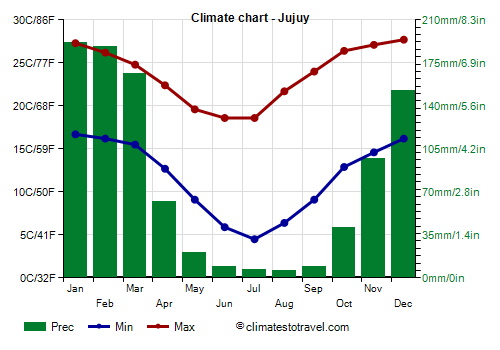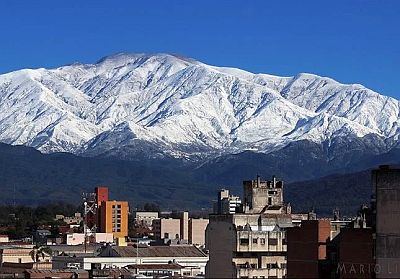Select units of measurement for the temperature and rainfall tables (metric or imperial).
Average weather, temperature, rainfall, sunshine hours

The climate of San Salvador de Jujuy is
subtropical, affected by altitude, with dry, mild winters (but during which it can get cold at night), and warm, rainy summers. In summer, the rains often occur in the form of thunderstorms.
The city is located in northern Argentina, just south of the Tropic of Capricorn, in a valley at the foot of the Andes, at 1,250 meters (4,100 feet) above sea level.
In
winter, the difference in temperature between night and day is often significant.
Snow in Jujuy is very rare, both because the winter is dry and because the tropical sun usually warms the ground and raises the temperature a lot during the day. However, between July 16 and 18, 2010, there was a historic snowfall.
On the other hand, from May to September the temperature quite often drops to the freezing point or even below. In July 2007, it dropped to -6.4 °C.
During the day, it can get
hot all year round, in fact, the heat records exceed 30 °C (86 °F) even in winter. However, the hottest days of the year are usually recorded in spring, because in summer the rains lower the temperature a bit. In late November 2023, the temperature reached 40 °C (104 °F), and in late October 2019, 39.8 °C (103.6 °F).

Not far from Jujuy are very high mountains. About 45 kilometers (28 miles) northwest is the
Nevado de Chañi, 5,930 meters (19,455 ft) high, while 140 km (85 mi) to the west is the
Nevado Queva, 6,140 meters (20,144 ft) high.
To the north, instead, west of the first foothills of the Andes, is the
Quebrada de Humahuaca, a high-altitude valley, crossed by the Río Grande river (the same one that then flows through the city of Jujuy) and a UNESCO World Heritage Site. On the other hand, about 80 km (50 mi) to the northwest, at 3,400 meters (11,155 ft) above sea level, we find the
Salinas Grandes, a salt desert plateau.
The northern Andes are arid, however, from November to March there can be some rain, and above 3,700 meters (12,000 feet), in the early hours of the morning it can even snow, although it is the summer.
Best Time
To visit Jujuy you can choose autumn, from the end of March to mid-May, since it is a mild and fairly dry period (although it can get quite cold at night, especially in May). In winter it can get cold at night, although the air usually gets mild during the day. In spring, starting from mid-August, it can get very hot.
Jujuy - Climate data
In Jujuy, the
average temperature of the coldest month (July) is of
11.6 °C, that of the warmest month (January) is of
22 °C. Here are the average temperatures.
Jujuy - Average temperatures (1991-2020) |
| Month | Min | Max | Mean |
|---|
| January | 16.7 | 27.3 | 22 |
|---|
| February | 16.2 | 26.2 | 21.2 |
|---|
| March | 15.5 | 24.8 | 20.2 |
|---|
| April | 12.7 | 22.4 | 17.5 |
|---|
| May | 9.1 | 19.6 | 14.4 |
|---|
| June | 5.9 | 18.6 | 12.2 |
|---|
| July | 4.5 | 18.6 | 11.6 |
|---|
| August | 6.4 | 21.7 | 14 |
|---|
| September | 9.1 | 24 | 16.6 |
|---|
| October | 12.9 | 26.4 | 19.6 |
|---|
| November | 14.6 | 27.1 | 20.8 |
|---|
| December | 16.2 | 27.7 | 22 |
|---|
| Year | 11.6 | 23.7 | 17.6 |
|---|
amounts to
950 millimeters per year: so, it is at an intermediate level. It ranges from
5.9 millimeters in the driest month (August) to
191.5 millimeters in the wettest one (January). Here is the average precipitation.
Jujuy - Average precipitation| Month | Days |
|---|
| January | 192 | 14 |
|---|
| February | 188 | 14 |
|---|
| March | 166 | 13 |
|---|
| April | 62 | 8 |
|---|
| May | 21 | 4 |
|---|
| June | 10 | 3 |
|---|
| July | 7 | 2 |
|---|
| August | 6 | 2 |
|---|
| September | 9 | 2 |
|---|
| October | 41 | 6 |
|---|
| November | 98 | 9 |
|---|
| December | 152 | 12 |
|---|
| Year | 950 | 88 |
|---|
There are on average around 2200
sunshine hours per year. Here are the average hours of sunshine per day.
Jujuy - Sunshine hours| Month | Average | Total |
|---|
| January | 6 | 180 |
|---|
| February | 5.5 | 150 |
|---|
| March | 5 | 155 |
|---|
| April | 5 | 150 |
|---|
| May | 5 | 165 |
|---|
| June | 6 | 175 |
|---|
| July | 6.5 | 205 |
|---|
| August | 7.5 | 225 |
|---|
| September | 7 | 210 |
|---|
| October | 6.5 | 195 |
|---|
| November | 6.5 | 195 |
|---|
| December | 6 | 190 |
|---|
| Year | 6 | 2200 |
|---|